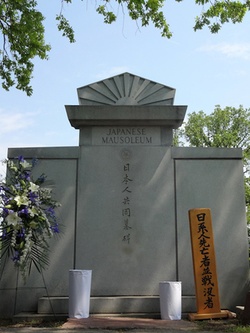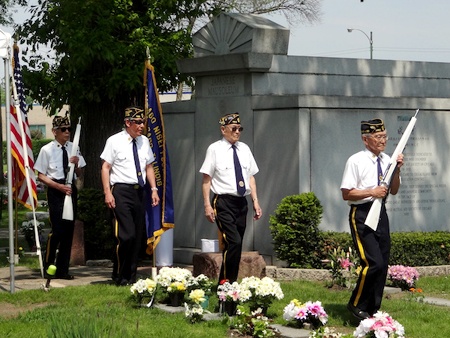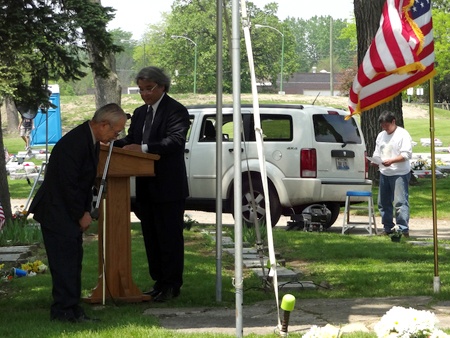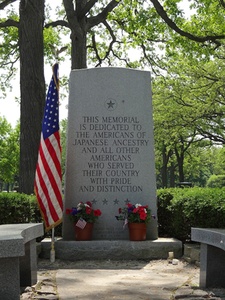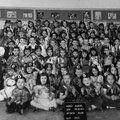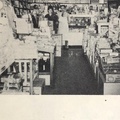In 1935, the Japanese Mutual Aid Society of Chicago began purchasing burial plots at Montrose Cemetery on the city’s North Side. Due to discrimination of the day, Montrose was one of few cemeteries in the area that would inter the remains of deceased persons of Japanese ancestry. In 1937 the Mutual Aid Society erected a Japanese Mausoleum and in 1938 began hosting an annual Memorial Day commemoration.
The majority of Japanese Americans in the Chicago area today are descendants of late 19th and early 20th century immigrants who, along with their American-born children, fell victim to President Franklin D. Roosevelt’s Executive Order 9066, which forcibly removed all persons of Japanese ancestry from the West Coast in 1942, spreading them among ten concentration camps further inland.
Prior to this, however, there were roughly 400 documented persons of Japanese ancestry living in Chicago, who were not affected by E.O. 9066’s mass incarceration. Because the West Coast remained closed to Japanese Americans until 1945, many resettled in Chicago due to its wealth of employment and educational opportunities. Through work and study early-release programs, and finally the closure of the camps, from 1942-1945 the Japanese American population in Chicago swelled from 400 to over 20,000.
The Japanese Mutual Aid Society was instrumental in assisting these early resettlers with housing, translation, as well as medical and legal services. As subsequent organizations were formed to lighten the load of transitioning former internees into their new homes, the Mutual Aid Society reverted to its maintenance of the mausoleum and purchasing of burial plots on behalf of the community.
2014 marked the 76th annual Chicago Japanese American Community Memorial Day Commemoration at Montrose Cemetery’s Japanese Mausoleum. With approximately two hundred people in attendance, it set under way at 11 a.m. with the Posting of the Colors by Chicago Nisei Post #1183’s Color Guard. Founded in 1949 by World War II veterans as the Rome Arno Post, the American Legion Chicago Nisei Post—which it was renamed in 1953—counts over 200 members nationwide from all branches of the military, representing veterans of campaigns dating from World War II through the present.
Ceremony emcee Robert Kumaki, Vice President of the Japanese Mutual Aid Society, followed with both opening remarks outlining the historical context of Montrose Cemetery with regard to the Nikkei community, and introductions of a series of bilingual Japanese/English prayers, chants, and songs led by the clergy and choirs of Chicago’s various Nikkei religious groups. An offering of flowers was then presented by representatives of several Chicago Japanese American organizations, not the least of which was the “Chicago Old Timers” represented by Iwao “Rocky” Yamanaka, a Chicago-born Nisei who grew up in the city’s pre-resettlement era.
“I remember when they built the mausoleum, in 1937,” he mentioned in a brief discussion after the service. “I was ten years old and have been coming to this event ever since. I’m the only one left from before the war, I don’t know of anyone else.”
Mutual Aid Society President Calvin Manshio, unable to attend this year’s commemoration, asked that in his stead his Gosei granddaughter, Ms. Alyssa Inskeep, read his remarks which outlined the names and achievements of recently-passed Chicago Nikkei community leaders. Preceding a pre-recorded rendition of Taps and the Retiring of the Colors by the Color Guard, Chaplain Makoto Fukuda closed with some final words of reflection.
The torch of Chicago’s Japanese American community’s leadership has been passed through the generations from the founding Issei of the pre-war period to the largely resettled post-war Nisei, and now the Sansei who have been raised as native Chicagoans. As a Yonsei I have begun attending community events with my Gosei children, and see others doing the same.
On a personal note, 2014 is the 110th anniversary of my Japanese ancestors’ arrival to the United States. For all their battles with discrimination and trials toward becoming accepted as fully American, I think the Issei generation would be heartened to know that their lives and contributions, as well as those of their American-born descendants who fought and died under the U.S. Flag on the world’s battlefields, have allowed for us to finally be able to assemble at will for such events without suspicion or hostility.
© 2014 Erik Matsunaga


